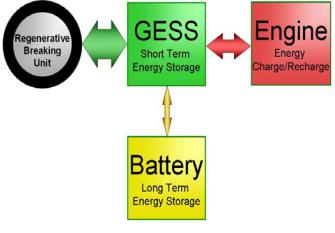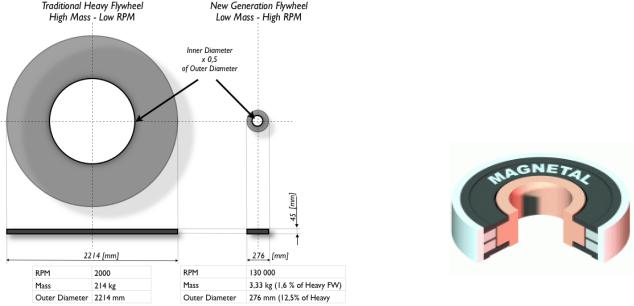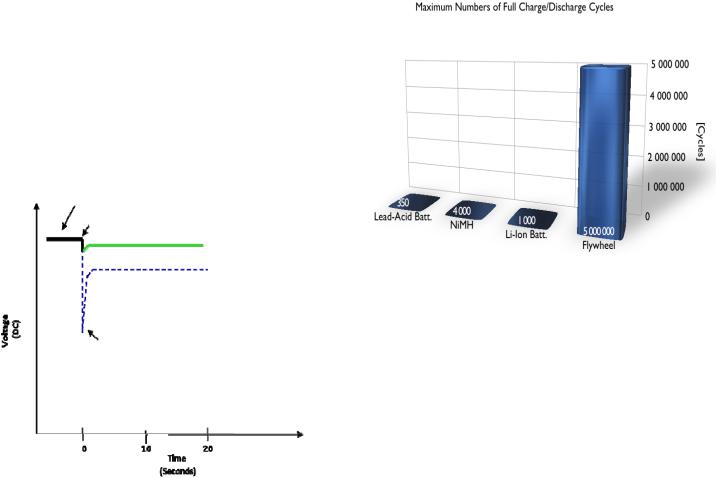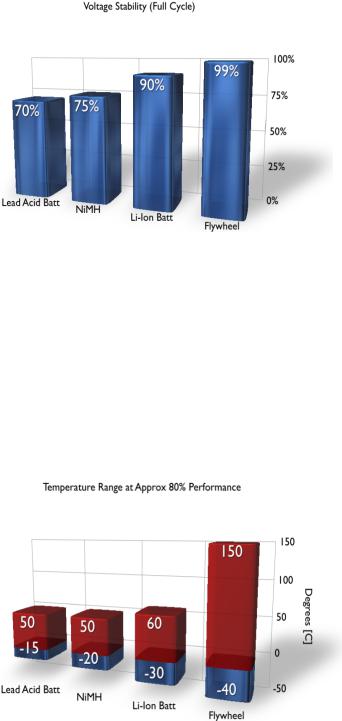

White Paper
Conceptual Description
Green Energy Storage System
|
|
|
|
|
|
|
|
|
|
|
|
|
|
|
|
|
|
|
|
|
|
|
|
|
|
|
|
|
|
|
|
|
|
|
|
|
|
|
|
|
|
|
|
|
|
|
|
|
|
|
|
GESS
A unique - environmentally friendly - energy storage technology for hybrid vehicle
Magnetal AB, Sweden, Phone: +46 (0)18-418 60 60, mail: info@magnetal.se, web: www.magnetal.se

Green Energy Storage System
GESS – Introduction
GESS is a light weight and ultra high speed flywheel battery technology system for optimal and extremely fast recovery and discharge of kinetic (motion) energy. The product can store more than 700 kJ (у 0,2 kWh) with a weight just under 8 kg and is targeting the consumer automotive sector. GESS adds value to any known energy storage solutions with a trouble free and reliable operation and extra ordinary life time expectancy.
|
|
|
|
|
|
|
|
|
|
|
1 |
|
|
|
|
Ekinetic |
mv |
2 |
|
|
2 |
|
||
|
|
|
!Speed is a heavenly gift1 /Gustaf de Laval
The GESS solution is about storing energy by using ultra high
speed in a flywheel. According to the well known formula above, by doubling the speed, the mass can be reduced by three quarters, and still maintain the same amount of kinetic (motion) energy. GESS will deliver a unique commercial solution for vehicles by utilizing new revolutionary and patented technologies.
!6by doubling the speed, the mass can be reduced by three quarters, and still maintain the same amount of kinetic
(motion) energy.1
GESS, the Kinetic Energy Battery
By maximizing the energy recovery process, GESS complements and enables rightsizing and usage of electrochemical batteries.
Therefore it is an optimal complementary solution to enable efficient, environmentally friendly and clean energy storage for automotives like hybrid and electric vehicles.
Flywheel battery solutions like GESS provide a very high
voltage stability of over 99%, which will prevent voltage sags.
charge cycles, battery lifetime as well as weight and volume of
any long term energy storage solution.
Figure 1: Suggested System Design Incorporating GESS for a
Hybrid Vehicle
GESS, The Construction
GESS incorporates a motor generator, a flywheel, controlling electronics and container. The total package stores more than
700 kJ with a weight just under 8 kg.
Being an ultra high speed flywheel application, GESS
capsules the rotating mass with military grade, state of the art, ballistic protection for maximum safety.
The core of GESS is based on a unique and patented
magnetic bearing solution, that enables a flywheel implementation with nearly no frictional losses or heat generation, compactness in design, long life expectancy and low cost due to a simplistic design.
!...GESS is a kinetic energy battery utilizing
unique bearing technology...1
The flywheel is constructed in light and compact carbon
A hybrid or electrical vehicle complemented with GESS will composite contained in a vacuum chamber to reduce drag. By
not only improve energy efficiency but also improve range, utilizing high speed velocity GESS enables significantly improved
kinetic energy storage compared to any known alternative
solutions.
2

GESS - Unique Flywheel Technology
The Missing Link
During the past decade new materials like carbon fiber and different composites have enabled a paradigm shift in flywheel technologies by containing the same energy levels by increasing rpm to over 100 000 rpm and reducing the weight to a fraction of
The bearing also has the unique property such that itsR characteristics are improving with increased speed. This is possible since the inductive component is increasing with increased speed. The uniqueness lies in the way to eliminate the eddy currents.
Dr R. Post, [Ref 3] explains the benefit of contactless bearings;
before.
!Non contacting magnetic bearings eliminate wear and minimize rotational drag losses, and ironless generator motor designs eliminate hysteretic losses. If there were no losses from aerodynamic drag, the rundown or self discharge lifetime, of the module supported by optimized magnetic bearings would be very long. Rundown times in excess of two years for magnetically levitated high speed rotors operated in vacuum were demonstrated 40 years ago.1
Figure 3: Magnetal Homopolar Electrodynamic Bearing
Figure 2: Comparison of Flywheels 5 Constant Energy 1 kWh
However, the missing link to commercialize the usage of flywheel
technology in consumer products has been the cost and design in
bearing technology.
!...no friction and long lifetime at a cost
suited for consumer products...1
GESS Uniqueness J The Bearing Technology
A fundamental component in GESS is MagnetalsR unique, and patented, solutions for Homopolar Electrodynamic Bearings
(HEDB). These magnetic bearings do not require any control electronics S nor any external power to operate. Furthermore they are simplistic and compact in design and suitable for mass production at low production cost.
The bearings offer full levitation and thus no physical contact
exists between the bearing and the shaft. The technology is making use of induced magnetic forces and since it is contactless, and virtually friction free, it does not generate heat, noise or wear
[Ref 2].
(HEDB).
EItKs all in the bearingF
According to R. Post [Ref 3] the bearings and rotor dynamics calculations are the two main issues to solve before being able to provide an efficient commercial kinetic recovery energy system (R. Post nomenclature S ZElectromechanical Battery[
EMB).
The above stated benefits are leading the high speed
flywheels into a new era by removing the last obstacles towards implementation.
The problem areas, now solved in GESS, are supported and
recognised by Dr A. Ruddell in his Storage Technology Report for the EC 5th Framework Programme [Ref 5].
!The energy usage during operation is relatively high mainly due to bearing losses, together with power electronics conversion losses. 66reduction of standing losses in the bearings is a key development objective. Many commercial flywheel products have a high power to capacity ratio, where the power electronics losses are significant.1
3

GESS – Background
Recovery Efficiency
GESS handles very fast energy uptake and discharge events and thus maximizes the energy recovery ability.
Dr R. Post explains benefits with flywheel solutions or
Electromechanical Batteries (EMB) [Ref 3].
!For example, the efficiency of energy recovery (kilowatt hours out versus kilowatt hours in) is projected to exceed
95%, considerably better than any electrochemical battery such as a lead acid battery. Power densities can soar to 5 to
10 kW/kg, several times that of a typical gasoline powered engine and up to 100 times that of typical electrochemical batteries. And because of its simple design and advanced materials, an EMB is expected to run without maintenance for at least a decade.1
Other Flywheel technology providers, such as Pentadyne, are
now proving the above stated facts, by delivering an energy efficiency of up to 99,85% and an uptime, over 20 years, at
99,994%. Pentadyne uses active magnetic bearings to reach these numbers while GESS uses the, compact, significantly less costly, less complex and passive HEDB solution.
!6GESS uses the, compact, significantly less
costly, less complex and passive HEDB
solution.1
Nominal Voltage
Grid Disturbance
With Flywheel
No Battery Response
SCoup de FouetS or Whiplash
Table 1: Illustration of the Ability for Flywheels to Act as a First
Line of Defence for Electrochemical Batteries [Ref Pentadyne]
An electrochemical battery solution has great difficulties to
manage fast energy events thus loosing much of its ability to fully
recover/provide energy. The phenomenon is called !Coup de
Fouet1 or ZBattery Whiplash[ as illustrated above [Ref
Pentadyne].
Life Time Expectance and Life Cycle Cost
GESS kinetic energy battery solution provides 5 000 000 full cycles [Ref 4]. GESS offers exceptional low Life Cycle Cost as well as an extremely small environmental footprint.
Charge/Discharge Cycle Robustness
Electrochemical batteries are sensitive to the amount and levels of charge and discharge cycles. A battery will typically last for up to 4000 full cycles [Table 2]. Discharge of more than 20 50% of total capacity will severely affect electrochemical battery life time expectancy. This means that about 50 80% of unused capacity, weight and volume has to be built in and will thus negatively impact the overall system performance as well as reducing the environmental benefit.
Table 2: Expected number of full (charge/discharge cycles [Ref 4]
GESS kinetic energy battery solution does not suffer from these
effects and can continuously deep cycle without suffering any system degradation.
“..GESS An enabler and complement to
electrochemical battery...1
Voltage Stability
Voltage instability, such as Zvoltage sag[, related to repeated starts and stops is a key factor to minimize. Modern electronic devices in for instance cars are very sensitive to inhomogeneous voltage supply. GESS and flywheel solutions provide a voltage
stability of 99% [Ref 4].
4

Table 3: Voltage Stability [Ref 4]
Electro chemical batteries have a less stable voltage supply
than flywheel solutions. Methods to mitigate this most often involves groups of capacitators to level the voltage fluctuation. By using a GESS Kinetic Energy Recovery Battery this is no longer needed.
Temperature Span
GESS solutions provides operation within a wide temperature range [ 40°C to 150°C] [Ref 4] increasing operational usability.
Table 4: Operating Temperature Range at у 80% Performance
GESS J An Enabler and Complement
GESS can mitigate the problem by acting as a first line of defence to smoothen the peaks of these fast Zbursts[ of energy.
Electrochemical batteries can then act to smoothen more long term power and energy requirements.
An electrochemical battery cell will only accept low voltage
direct current, while GESS accepts and delivers variable frequency alternating current at an operating voltage level chosen by the designer. When coupled to a power converter, GESS delivers its electrical energy at higher power levels per kilogram of mass than any known electrochemical battery.
Safety Issues
Recommendations from new safety initiatives, such as the EC funded Flysafe project and the DARPA assembled Flywheel
Safety and Containment Consortium [Ref 5], are considered in the GESS construction. Therefore, as mentioned, a protective hood, made of state of the art ballistic protection, is designed to withstand and contain any harmful energy released by an unforeseen system breakdown.
Gyroscopic Effects
Gyroscopic forces are emerging when spinning up a mass. Trying to depart from a straight line course, the gyroscopic effects will result in a resisting force.
Post [Ref 3] suggests different methods to solve this issue:
!The effects can be minimized by vertically orienting the axis of rotation6.By operating the EMB modules
(Flywheel) in pairs one spinning clockwise, the other counter clockwise the net gyroscopic effect on the car would be nearly zero61
Environmental Benefits and Considerations
Thanks to GESS low idle losses, low heat generation and possibility to accumulate fast energy events S GESS is an optimum green energy solution.
Furthermore the GESS solution does not impact the
environment with hazardous materials (HAZMAT) since the components consists of carbon composite, epoxy resin, steel and rare earth metals (NdFeB).
Disposal of the system is simplified by its simple
construction, small amount of used material, and few material components and parts.
Thanks to GESS long life time expectancy, the system does
not generate any significant logistics footprint.
Other Initiatives
In F1 racing there are today several companies trying to implement KERS systems (Kinetic Energy Recovery Systems).
Many are making good progress. There are though several obstacles on the way to a fully commercialized solution, namely; friction, heat and life time S all related to the bearings. These issues have not only been identified by the GESS team but also by Post and Ruddell [Ref 3, 5].
GESS have, by its access to MagnetalRs passive technology of
Homopolar Electrodynamic Bearings, solved these problems.
5

Expertise
Flywheel technology has been intensely studied more than twenty years by Dr Torbjörn Lembke who started as a diploma engineer at SKF.
Dr Lembke is an active senior advisor in the GESS team and is a recognised authority with experience from multiple industries and universities in
regards to bearings, magnetism and vacuum applications.
He is also the founder of the IEEE Magnetics Sweden Chapter, where he was the chairman for ten years.
In 1997 he participated in "Vision 21", a visionary study made by
Elforsk to investigate the transmission and distribution grid for the 21 century, incorporating novel storage technologies like flywheels and superconducting coils.
In 1999 Lembke presented some of the results in the newly founded "Sveriges Energiting" which is now the largest annually arranged energy symposium in Scandinavia.
In 1999 he was also the chairman of the flywheel session at
Intelec in Copenhagen.
In 2002, on behalf of the World Bank he assessed the possibilities to reduce investment costs in local grids by introducing battery banks and flywheels for energy storage.
In 2005 he defended his PhD thesis on low loss magnetic bearings for high speed applications, a vital component in successful flywheel design.
Finally, Dr Lembke is the inventor of MagnetalRs unique
Homopolar Electrodynamic Bearing technology [Ref 2]
Key Words
Passive Homopolar Electrodynamic Bearing (HEDB), Green
Energy Storage System (GESS), Flywheel, Vacuum, Kinetic
Energy, Electromechanical Battery (EMB), Life Cycle Cost (LCC)
References
1.K. Hallbach, !Design of Permanent Multipole Magnets with Oriented Rare Earth Cobalt Material.1 Nuclear
Instrument and Methods 169 (1980)
2.T.A. Lembke, !Design and Analysis of a Novel Low Loss
Homopolar Dynamic Bearing1 PhD Thesis, KTH,
Stockholm, Sweden (2005), ISSN 1650 674X
3.R. Post !The Electromechanical Battery1 Article in
Science & Technology Review (April 1996)
4.J. Cibulka, !Kinetic Energy Recovery System by means of flywheel energy storage1 , Advanced Engineering,
3(2009), ISSN 1846 5900
5.A. Ruddell !Investigation on Storage Technologies for
Intermittent Renewable Energies: Evaluation and recommended R&D strategy1, CCLRC Rutherford
Appleton Laboratory, WP Report: Storage Technology
ST6: Flywheel, Project funded by European
Community under the 5th Framework Programme
(1998 2002)
6
